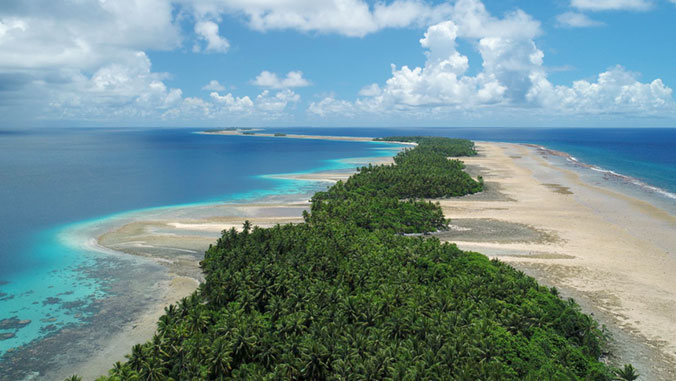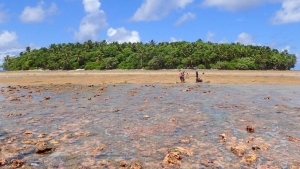
Low-lying reef islands such as the Marshall Islands could become unstable by mid-century and permanently lost as soon as 2080 if measures to adapt to rising sea levels are not implemented, according to research led by University of Hawaiʻi at Mānoa Earth scientists.
Coral reef atoll islands are home to thousands of people around the world, but researchers still do not agree on how sea-level rise will impact these islands and their communities. Conflicting scientific messages generate confusion and can hinder progress in building community resilience to accelerating sea-level rise.
In the study published in Earth’s Future, Haunani Kane and Chip Fletcher, from UH Mānoa’s School of Ocean and Earth Science and Technology, used an integrated model that incorporates the 5,000-year geological history of the Marshall Islands with updated emissions and sea-level rise projections to understand what will happen to atoll islands over the course of the century. The results suggest higher water levels will rapidly increase flooding by extreme tides and more destructive waves. Salt water inundation will increasingly inundate the Marshall Islands and deteriorate their freshwater resources and agro-forests as early as in the decades leading up to mid-century.
Reducing exposure, increasing resilience

Islanders can proactively bolster their islands’ natural ability to adapt and change by preserving and restoring reef ecosystems that protect coasts and provide new sediment to the structure of the island. Communities can reduce their exposure to climate-related hazards with nature-based and biocultural solutions such as wetlands, vegetated coastal buffers, aquaculture, and other projects that increase the distance between the shoreline and community assets. Slowing coastal erosion and wave inundation while increasing habitat and biodiversity, carbon sequestration, recreation opportunities, and cultural activities, are important for increasing resilience, especially now, in the first half of the century.
Reef islands are low-lying islands made up of wave deposited sand and coral. They support lush agro-forests and thin rain-fed freshwater aquifers. Researchers have debated how these islands will be affected by climate change-driven sea-level rise because they have not been subjected to rising seas before. Most of these islands formed in the past few thousand years as sea level in the tropical Pacific was lowering in response to deepening ocean basins surrounding formerly glaciated northern continents. Now, because of global warming, sea level is rising and the rate of rise is accelerating.
“Some scientists argue that because of their geologic history, reef islands could be resilient to human-caused sea-level rise, but most such studies consider islands and their people to be separate entities,” said Kane, a coastal geologist with UH Hilo and lead author of the study.
“We found that as really being disconnected from the way that we live on islands,” she added. “This study eliminates some of the confusion and the gaps in knowledge related to how sea-level rise will impact low-lying islands because it considers the impacts upon and resilience of both the place and the people.”
Modeling future change
To address this disconnect, Kane and Fletcher developed a model that treats islands and their people as inseparable components. The model uses a mixture of fossil data, historical photographs, and modern observations of tide and wave events to understand the geological processes of the Marshall Islands over 5,000 years. Using this information about how the islands have grown and responded to past changes over time, they projected each island’s ability to adapt to the increasing rate of sea-level rise.
They found that individual islands will respond slightly differently depending on their shape and location.
“Even within one nation, there are differences in how islands will respond,” said Kane.
“Getting this right is critically important,” said Fletcher. “There are disturbing signals that planning for multi-meter sea level rise this century is the prudent course of action. Fossil fuel use is outpacing renewable energy. Five years ago, 189 nations promised to tighten emission restrictions by 2020, only 10 have followed through. The rate of global warming has departed from a trend of several decades. Researchers have concluded that portions of the West Antarctic Ice Sheet are showing the first signs of structural weakening. And we have a lack of scientific thinking at the highest levels of government. In my mind, these add up to a very grim future for shoreline communities around the world who fail to act.”
For more see SOEST’s website.
The Link LonkOctober 31, 2020 at 04:10AM
https://ift.tt/3oEzblH
Sea-level rise challenges can be met by atoll communities - UH System Current News
https://ift.tt/2CoSmg4
Sea
/cloudfront-us-east-2.images.arcpublishing.com/reuters/CZF6NULMVVMEXHOP7JK5BSPQUM.jpg)
No comments:
Post a Comment